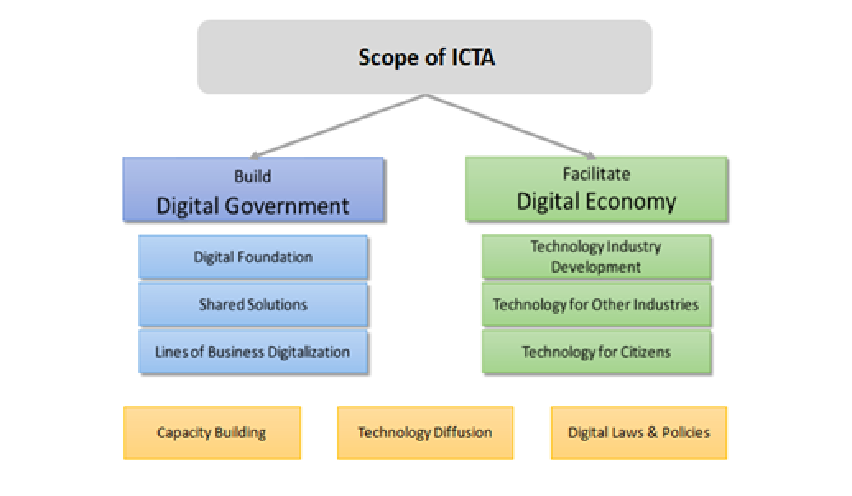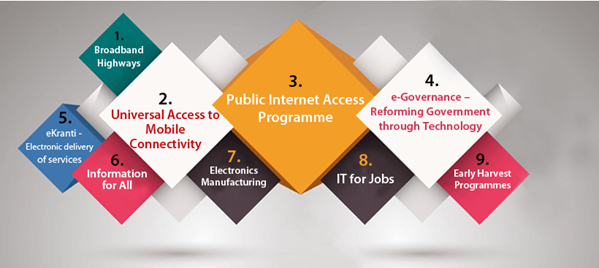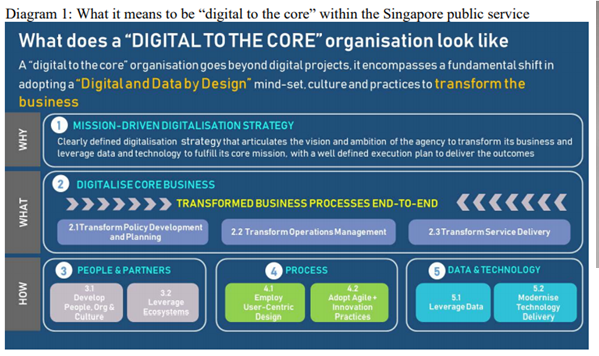The Foundation In Realizing a Digital Dream
By Eng. Lanka Perera
Introduction
The concept of e-governance has immerged in the 1990s. In OECD/Inter-American Development Bank publication on Digital government, Broadband Policies for Latin America and the Caribbean: A Digital Economy Toolkit, (2016) E-governance is explained as the usage of Information and Communication Technology (ICT) and primarily internet for better governance. In general e-governance is understood as the usage of ICT for public service delivery and exchange of information. This concept has gradually evolved from e-government and grown to digital-government by now. Digital government is defined by OECD/Inter-American Development Bank as the usage of digital technologies, as an integral part of governments modernization strategies, to create public value. In this concept focus is not only on providing government services on-line. Digital government is the usage of digital technologies to add value to public service delivery. It is not creating a digital replica of the once manual processes. But it is making the government processes digital by design. However, at present the two terms e-government and digital government are used interchangeably.
The governments around the world have worked relentlessly to achieve successes in e-governance, which some countries have succeeded in and some countries are yet to achieve. We need to look at the success factors or failure factors in this journey, and what lessons a country like ours can learn from the success stories.
One point is to be noted, whatever the state of digital government of a country, one key imperative towards realizing the digitalization dream of a country can be identified. That is the presence of a strong policy and strategic framework for digital government of the country. We may draw insights from the policies and strategic frameworks for digital government of other countries, which may be adapted in the journey to realize our digital dream.
In this article attention was drawn to four countries including Sri Lanka. Others being India, New Zealand and Singapore. Sri Lanka and India are two lower middle income developing, SAARC member countries where India is the economic giant in the South Asian Sub-region having a GDP of 2,622,983.73 US $ as per World Bank (2021) data. India being our closest and a very influential neighbour it is worth drawing insights from. Singapore on the other hand which is also an Asian country and is the world’s 11th most developed country having a Human Development Index (HDI) of 0.938 in 2019 as indicated in United Nations Development Programme (UNDP) (2021) records, was also considered. It is an often-quoted fact that several decades ago Singapore aspired to become like Sri Lanka at that point in time, which by now has turned around and we may have much to learn from the country. In contrast New Zealand belongs to Oceania and ranks 14th in most developed country range. Further as per the United Nations (2020), UN E-Government Survey 2020, e-Government Development Index (EGDI) ranks of New Zealand, Singapore, India and Sri Lanka are 8, 11, 85, 100 respectively. Among which New Zealand and Singapore are in very high EGDI country category. The four countries are poles apart in many factors such as economic development, e-government development and other socio-political factors, it would be interesting to look through their digital government policies and frameworks.
Country Overview of Digital Government Policies and Strategies
Distinct country perspectives of digital government policies and strategies are discussed below.
Sri Lanka
As per Information and Communication Technology Agency (ICTA) e-government initiatives of Sri Lanka had commenced around year 2004, under the e-Sri Lanka Development Project funded by World Bank during 2004-2011. Prior to e-Sri Lanka project Sri Lankas’ e-governance actions has been ad-hoc even though a Ministry for ICT was available. The current active initiative on this regard is the Digital Sri Lanka initiative under which Industry Development, Digital Infrastructure, Legal Framework & Development, Policy Framework and Development, Digitization in Government, Human Resource Capacity Building, Security and Citizen Empowerment perspectives have been considered.
The currently available national digital policy covers a time horizon of 2020 – 2025. This policy tackles two aspects, Digital Government and Digital Economy, as depicted in Figure 1.
According to ICTA Digital Government pillar is expected to enable better communication between the government and the citizens apart from making available government services via ICTs to the public. Under the Digital Economy pillar, digitization of businesses and digitally connecting these businesses to global value chains and global production networks is considered. Further capacity building, technology diffusion and digital laws and policies are considered as enablers for realization of Digital Government and Digital Economy.
 Figure 1 : National Digital Policy outlines Sri Lanka’s, ICTA (2021)
Figure 1 : National Digital Policy outlines Sri Lanka’s, ICTA (2021)
Source: https://www.icta.lk/policy-framework/
The policy is developed in order to achieve the objectives of ICTA. When considering policy frameworks related to digital government, Sri Lanka has two major frameworks in place. Those are ICT policy for Government and the National ICT Policy. The ‘ICT policy for Government’ acts as a guide for government agencies, to comply with when assuring their development and delivery of public service. Also this is expected to ensure consistency among government organizations and gives minimum requirements for organizations to build their own organizational ICT policy.
On the other hand the national ICT policy recognizes ICT as a major enabler for economic growth of the country. Under this, focus is on an enabling infrastructure, legal frameworks, information security and standards, human resources capacity building, socioeconomic development, and utilizing ICT for trade facilitation by e-commerce and e-government.
India
Digital India is an umbrella programme under the current political administration which covers nine pillars of growth areas, namely Broadband Highways, Universal Access to Mobile Connectivity, Public Internet Access Programme, e-Governance: Reforming Government through Technology, e-Kranti - Electronic Delivery of Services, Information for All, Electronics Manufacturing, IT for Jobs and Early Harvest Programmes.
 Figure 2: Nine Pillars of Growth - Digital India
Figure 2: Nine Pillars of Growth - Digital India
Source: https://www.digitalindia.gov.in/content/programme-pillars
.
The pillars, e-Governance: Reforming Government through Technology and e-Kranti - Electronic Delivery of Services are directly related to the e-Kranti: National e-Governance Plan (NeGP) 2.0 of India. The vision of e-Kranti is ‘Transforming e-Governance for Transforming Governance’.
The e-Kranti initiative is based on 12 main principles as stated below;
- Transformation and not Translation – By digitalization significant improvement in productivity is expected.
- Integrated Services and not Individual Services - A common middleware and integration of the back end processes of government is expected.
- Government Process Reengineering (GPR) to be mandatory in every Mission Mode Projects (MMP)
- ICT Infrastructure on Demand – ICT infrastructure to be provided to Government institutions on demand, without each institute investing in dedicated infrastructure.
- Cloud by Default – Government Cloud to be used by all government organizations. Private clouds would allowed only with stringent assessment and government approval. Each government institute to own on-premise data centres are not expected.
- Mobile First – Enable delivery of service through mobile.
- Fast Tracking Approvals – Fast track approval to projects.
- Mandating Standards and Protocols – E-Governance standards and protocols as notified by Department of Electronics and Information Technology (DeITY) be mandated in all e-governance projects.
- Language Localization – Availability of digital services in Indian Languages
- National GIS (Geo-Spatial Information System) - NGIS to be leveraged as a platform and as a service in e-Governance projects.
- Security and Electronic Data Preservation - The National Cyber Security Policy 2013 must be followed.
- All new and on-going e-Governance projects as well as the existing projects, which are being revamped, should follow the key principles of e-Kranti.
e-Kranti consists of a total of 31 Mission Mode Projects (MMPs).
Singapore
Singaporean digital journey has started over 30 years ago in 1980, with the national computerization programme. Singapore has published its current policy termed as ‘Digital Government Blueprint’ (DGB) in 2018 and has issued an updated version in 2020. This has been built upon previous e-government master plans of Singapore. The Government of Singapore identifies its vision to build a nation which is “Digital to the Core, and Serves with Heart”. Figure 3, illustrates the governments vision to be ‘Digital to the Core’
 Figure 3: 'Digital to the Core' Illustration, Government of Singapore (2020)
Figure 3: 'Digital to the Core' Illustration, Government of Singapore (2020)
Source: https://www.tech.gov.sg/files/media/corporate-publications/dgb-public-document_30dec20.pdf
Government of Singapore, DGB consist of a six-fold strategy to build a Digital Government. The six dimensions are:
- Integrating services around citizen and business needs;
- Strengthening integration between policy, operations and technology;
- Re-engineering the Government’s ICT infrastructure;
- Operating reliable, resilient and secure systems;
- Raising own digital capabilities to pursue innovation; and
- Co-creating with citizens and businesses, and facilitating adoption of technology.
New Zealand
The currently active strategy for digital-government of New Zealand, published as ‘Strategy for a Digital Public Service’ is a successor to the ICT strategy (2013, amended 2015). As explained in the ‘Strategy for a Digital Public Service’, the strategy is focused on a people-first, system-wide approach. (https://www.digital.govt.nz/digital-government/strategy/strategy-summary) Also, the strategy places high regard to the aspirations of Maori, the indigenous people of New Zealand as well as the diverse requirements of all New Zealanders while giving due consideration to the country’s unique strengths.
The strategy aims to support the governments’ priorities;
- a growing economy
- improving the wellbeing of New Zealanders and their families
- building a better country which all New Zealanders can be proud of.
One outcome expected of the policy is to achieve ‘a modern, agile and adaptive public service’. The strategy further identifies below collective behaviours for ensuring this objective.
- Act as a unified public service
- Make people-centred decisions
- Collaborate and co-create (Government collaborate with citizens and allow developing solutions by citizens, with concept of services by communities for communities)
- Digital transformation in accordance with tikanga Māori (the customary system of values and practices
- Act quickly and innovate
- Prioritise value for money
- Foster a learning environment
- Strive for an open, accountable public service
The strategy further out lines key focus areas to achieve its digital government vision. These are;
- Integrated services for people and business: Across agency integrated services, rather than silos.
- Leadership, people, culture: expects a new digital leadership culture which is non-hierarchical and spreading at all levels.
- Foundations: Design government digital architecture in order to achieve government agency interoperability and single-portal access for citizen.
- Investment: to consider all-of government strategic view and people-centric attitude in decision making of investments.
- New ways of working: Not just including new digital technologies for operation, but explore new ways of working itself
Key Takeaways from the Policies and Strategies
Irrespective of the state of economy or geo-political stance of the country, the digital government strategies discussed few common aspects. These are integrated solutions and inter-operable digital government platform, improved citizen participation in governance via e-governance, innovative technology usage, human capacity building and promotion of a learning culture etc.
Another core concept accepted in all policies is the consideration of people over technology. The primary idea is not to simply digitize government operations, but to transform operations incorporating digital technologies, in order to satisfy the requirements or aspirations of citizens.
The strategies of the two highest EGDI ranking global e-government leaders studied, namely New Zealand and Singapore, stresses co-creation of digital services with the collaboration of government and public, people-first concept, and adherence to community core values while implementing digital government.
Below key concepts of digital government policy frameworks and strategies can be identified in the considered countries.
People
- People-Centred and People-first approach
- Strong digital leadership
- Knowledge-based, learning culture
- Collaboration of government and the public for value co-creation
- Human capacity building
- Value aspirations and needs of local/ indigenous communities
Processes
- Transformation of service delivery
- Government process re-engineering
- End to End Digital Processes
- Establishing legislative foundation (legislation related to security, privacy, electronic transactions etc)
Technology and Data
- Data classification, standardization and data exchange among government agencies
- Utilization of innovative and novel technologies
- Across government basic services and infrastructure as a digital foundation (common middleware platform and government cloud)
- Standardised and interoperable systems
A firm policy framework and strategy can be considered as the foundation to realizing the digital dream of a country. Further by looking at these four countries it can be identified that a digital government policy framework would always be a work in progress, which should iteratively improve. These should be reviewed, revised and upgraded, proactively and periodically considering stakeholder aspirations and local and global digital eco-systems.
 Eng. Lanka Perera
Eng. Lanka Perera
CEng., MIESL
Reading MBA in E-Governance, KDU
PG. Dip in Electrical Installations, UoM
B.Tech (Eng) (Hons) (OUSL)




